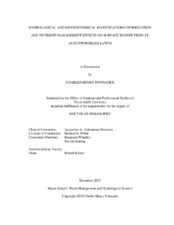| dc.description.abstract | St. Augustinegrass (Stenotaphrum secundatum (Walt.) Kuntze) performance under conservation irrigation is poorly described. Further, the effect of summer drought stress on the lawn ecosystem could have unforeseen implications for storm water runoff quantity and quality. To address these concerns, two field studies were conducted in College Station, TX, to examine the relationships between St. Augustinegrass health, conservation irrigation management, and surface runoff chemistry. In experiment 1, turf performed adequately when receiving water at 60% of historical average ETo, but substantial overwatering occurred during the wettest year. Experiment 2 was conducted at a state-of-the-art surface runoff capture and measurement facility with the objectives of estimating effective rainfall in lawns, quantifying NO3-N losses due to irrigation and fertility management, and investigating relative partitioning among N species in runoff. Commonly used effective rainfall coefficients did not result in accurate estimates of effective rainfall. Rather, methods which accounted for initial abstraction and subsequent rainfall independently were more accurate. Reduced runoff volumes associated with deficit irrigation equated to a short-term reduction in NO3-N exports. However, the resultant accumulation of N in fertilized sites led to higher NO3-N concentrations over time. Nitrate-N concentration was typically below 5 mg L^-1 but peaks in excess of 20 mg L^-1 were measured during late winter in one year. Aside from this atypical peak, the largest portion of total dissolved N (TDN) was in the organic form (DON), while NH4-N was typically the smallest portion. Overall, deficit irrigation practices appear to be effective methods for conserving water if occasional turf attrition can be tolerated. Under deficit irrigation, reduced fertility appears warranted for mitigating potential N pollution over time. Dissolved organic N as an export from turf has largely been ignored by previous research. These data suggest DON could be the primary species of N leaving turf sites, and further study of the quality of N within this pool is warranted. | en |


